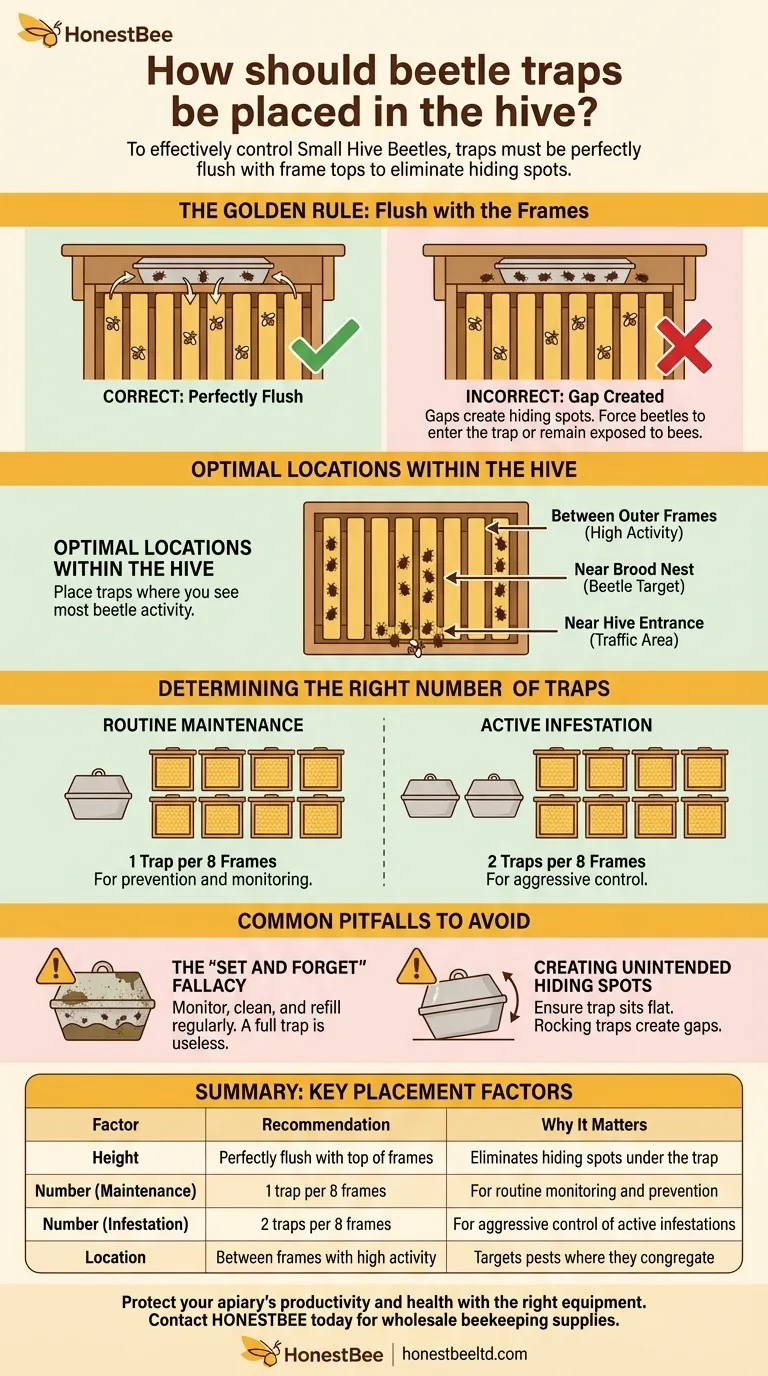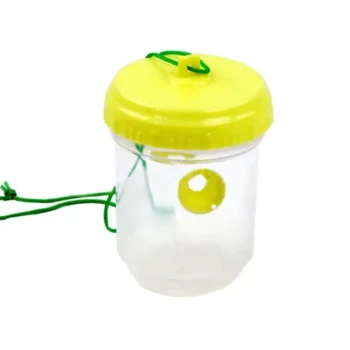To effectively control Small Hive Beetles, your traps must be placed perfectly flush with the top of the frames inside your hive. Any gap, no matter how small, creates a space for beetles to hide under the trap instead of being forced to enter it, defeating its entire purpose.
The core principle of hive beetle control is not just trapping, but eliminating beetle hiding spots. Proper trap placement is a critical part of a broader strategy to make the hive environment hostile to beetles and supportive of the bees' own defensive behaviors.

The Principle of Proper Trap Placement
Understanding beetle behavior is the key to making your traps work. Beetles are drawn to dark, tight spaces where they can hide from bees, breed, and feed.
Why "Flush with the Frames" is Critical
Small Hive Beetles instinctively seek crevices to evade the guard bees.
If a trap is not placed snugly against the tops of the frames, the space underneath it becomes a perfect, protected hiding spot. This turns your solution into part of the problem.
By ensuring the trap is flush, you force the beetles crawling across the frames to either enter the trap or remain exposed to the bees.
Optimal Locations Within the Hive
While the flush placement is non-negotiable, you have strategic options for where to position the traps.
Place traps between frames where you see the most beetle activity. Beetles are often found in the outer frames or near the brood nest.
Positioning a trap near the hive entrance can also be effective, as it's a high-traffic area for both bees and incoming pests.
Determining the Right Number of Traps
The number of traps required depends entirely on the level of beetle pressure your colony is facing.
For Routine Maintenance
As a standard preventative measure, use one beetle trap for every eight frames in a hive box.
This allows you to monitor the beetle population and catch pests before their numbers grow out of control.
For Active Infestations
If you have a visible infestation, you must be more aggressive. Double the number of traps.
Use two beetle traps for every eight frames to significantly increase your capture rate and quickly reduce the beetle population.
Common Pitfalls to Avoid
Effective pest management requires avoiding common mistakes that can render your efforts useless.
The "Set and Forget" Fallacy
Traps are not a one-time solution. You must monitor them during your regular hive inspections.
Check to see if they are full, clean them out, and refill the bait or oil as needed. A full or dried-out trap is just a piece of plastic taking up space.
Creating Unintended Hiding Spots
The most common error is improper placement. Double-check that the trap sits perfectly flat and flush against the top bars of the frames.
If your trap can rock or slide even slightly, it has created a gap that beetles will exploit.
Matching Your Strategy to Your Goal
Your approach should be tailored to the specific needs of your colony.
- If your primary focus is prevention and monitoring: Use one trap per hive body, place it flush between two frames, and check it during routine inspections.
- If your primary focus is controlling an active infestation: Use two traps per hive body, place them in the areas of highest beetle concentration, and check and service them frequently.
Proactive and precise trap placement empowers your bees to defend their colony and ensures a healthier, more productive hive.
Summary Table:
| Key Placement Factor | Recommendation | Why It Matters |
|---|---|---|
| Height | Perfectly flush with top of frames | Eliminates hiding spots under the trap |
| Number (Maintenance) | 1 trap per 8 frames | For routine monitoring and prevention |
| Number (Infestation) | 2 traps per 8 frames | For aggressive control of active infestations |
| Location | Between frames with high beetle activity | Targets pests where they congregate |
Protect your apiary's productivity and health with the right equipment. Proper beetle trap placement is just one part of a successful pest management strategy. HONESTBEE supplies commercial apiaries and beekeeping equipment distributors with high-quality, wholesale beekeeping supplies designed for effectiveness and durability. Let us help you build a stronger defense for your hives.
Contact HONESTBEE today to discuss your wholesale supply needs and keep your colonies thriving.
Visual Guide

Related Products
- Black Plastic Beetle Barn Hive Beetle Trap for Beehives
- Reusable Aluminium Beetle Trap for Small Hive Beetles Silver Bullet
- Reusable Clear Small Hive Beetle Traps for Beehives Beetle Trapping Tools
- Removable Washable Hive Beetle Trap Attractants for Small Hive Beetles
- Plastic Beetle Blaster Trap Beekeeping Tools and Supplies
People Also Ask
- What is the recommended number of beetle traps per hive? Optimize Your Hive's Beetle Defense
- How do hive beetle traps work? A Beekeeper's Guide to Non-Chemical Control
- Why are hive beetle traps important for beekeepers? Protect Your Hive from a Devastating Infestation
- What tips can help prevent hive beetle infestations? Build Strong Colonies & Master Apiary Hygiene
- What should be done if a hive shows signs of a small hive beetle infestation? Protect Your Hive Now



















